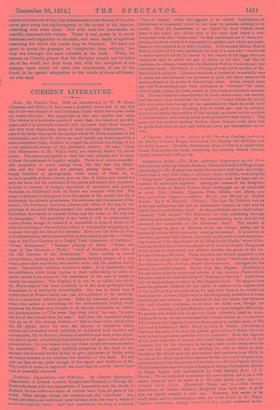CURRENT LITERATURE.
Rome. By Francis Wey. With an Introduction by W. W. Story. Chapman and Hall.)—It may seem a doubtful encomium to say that this is the very largest of the Christmas books which have come under our notice this year. But magnitude in this case implies real value.
The volume is a handsome quarto of more than five hundred and fifty pages, and it is profusely adorned with no fewer than three hundred
and fifty wood engravings, many of them full-page illustrations. We cannot do better than quote the opinion which Mr. Story expresses in his introduction, and than Mr. Story we need hardly say there cannot be a more competent judge, whether we regard his personal knowledge of art or his special knowledge of this particular subject. He says, "They [the illustrations in Mr. Wey's book] are carefully drawn by clever artists. The scenes and points of view are well selected, and in many of them the sentiment is happily caught. There is of course consider- able inequality of merit among them, but the best are admir- able, and the least good are perhaps among those which are deeply indebted to photography, while many of them do, as far as is possible without colour, give an idea of Rome, and record not only the facts, but the sentiment of the places and scenes they represent. In point of number of designs, excellence of execution, and general character, no illustrated book on Romo can compare with this. The range of pictures is very groat, from the games of the people, the life of the streets, the priestly processions, the costumes and ceremonies of the church, the fountains, churches, palaces, and villas of the day, to the paintings of the early Italian masters, the catacombs of the primitive Christians, the statues of ancient Rome, and the ruins of the city and the Campagna." The speciality of the book, it will be understood, is modern Rome, though of course it is impossible to treat of Rome at all without touching on the antiquity which is continually cropping up, so to speak, through the life of the present. Hero are the titles of some of the illustrations, taken consecutively as they stand in the list :—" Paint- ings of the First Century on a Chapel Vault (Catacomb of Callistas)" "Ponta Nomentano," "Romans playing at Mora," "Street and Apse of San Giovanni e Paolo," "Arch of Dolabella, and Gate of the Old Convent of the Trinitarians." Their variety is indeed extraordinary, making the book a singularly faithful picture of a city where, more than anywhere, the ancient world and the modem visibly meet. One adverse criticism we have to make. It is lamentable that the publishers, while doing justice to their undertaking in other re- spects, should have entrusted the translation of the text to hands so utterly incompetent. The English, if it can be so called, into which Mr. Wey's original has been rendered, is of the most grotesque kind. Sometimes it is absolutely unintelligible. One has to think how it would stand in French before one can get a glimpse of the meaning; that is a somewhat tedious process. Take, for instance, this passage, where the author is accounting for the extraordinary vitality which preserves the Roman race, in spite of all adverse influences of climate and circumstances :—" The water that they drink," he says, " is pare, the fire of the climate does the rest." And then the translator makes him go on in this strange fashion:—" Add to these facts, which place the old physic above the new, the absence of industries which etiolate, and of studies which cultivate in childhood both intellect and consumption, life in the sun, absence of ambition and care, a free expan- sion left to youth, or health-giving indolence at all ages,—theso are true preservatives; for you cannot even say these people are accustomed to the insalubrity." We -might multiply quotations of the kind to any
amount, but it would hardly be fair to give specimens of faults, while we cannot transfer to our columns the beauties of the book. We will only say that we see quite enough of the vigour and liveliness of Mr. Wey's style to make us regret all the more that its merits should have been so miserably obscured.


































 Previous page
Previous page